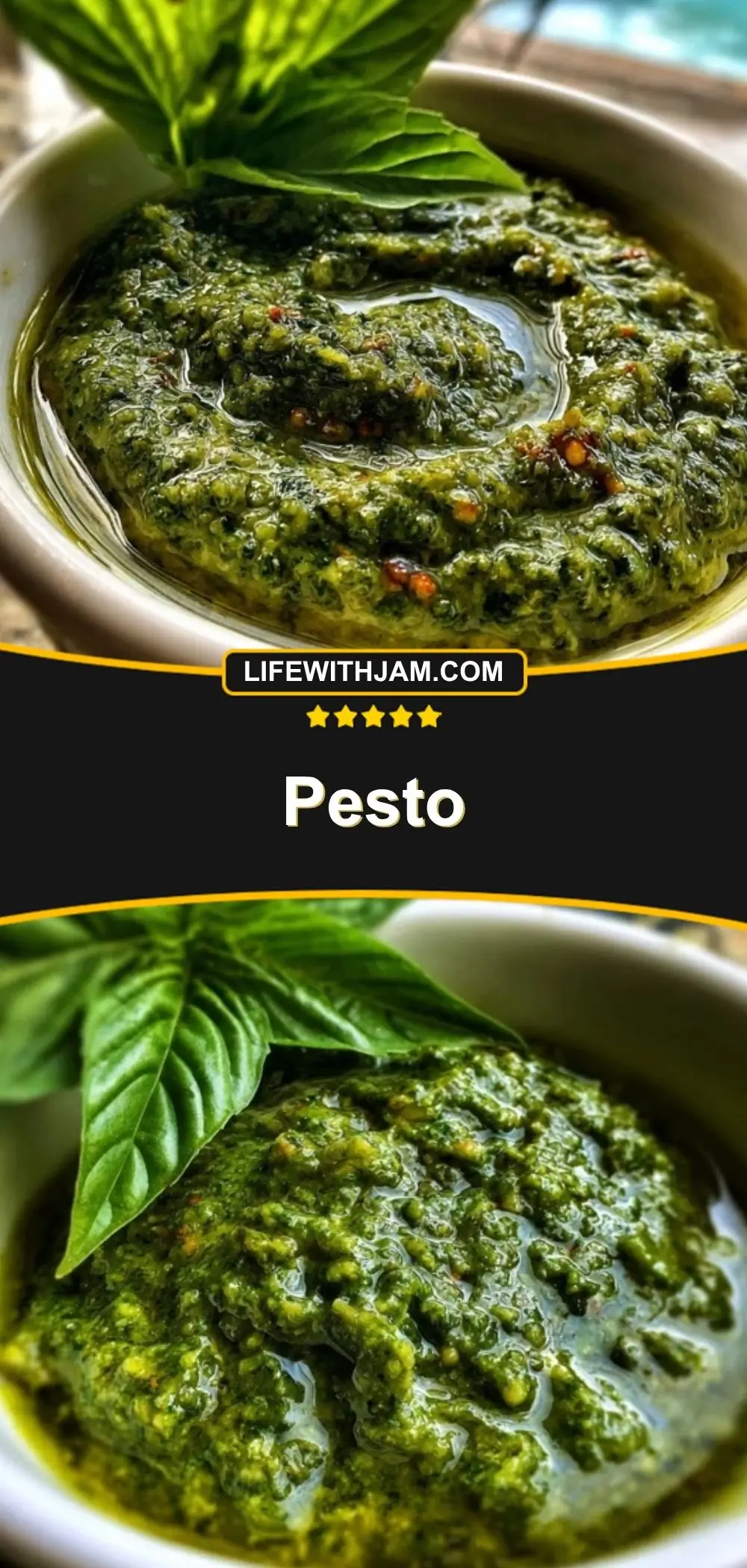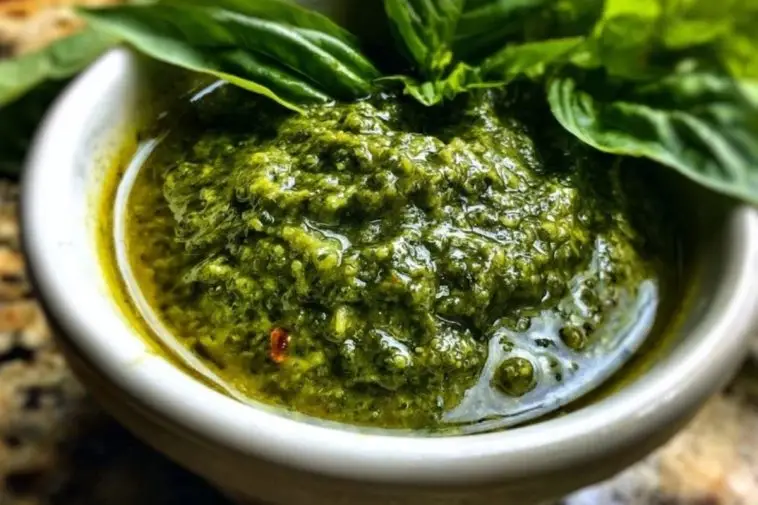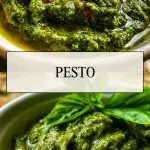Few sauces can claim the fresh vibrancy and deep flavor punch that classic basil pesto delivers. This emerald green beauty is a timeless staple in Italian kitchens and a brilliant addition to any meal, whether you’re tossing it with pasta, spreading it on sandwiches, or swirling it into soups.
Made with just a handful of simple ingredients, this pesto is a celebration of quality. Its rich, garlicky aroma, nuttiness from pine nuts, and sharp bite of Parmesan all come together with luscious olive oil for a silky, bold condiment that elevates even the most basic dishes.
Can I Use Store-Bought Basil or Should I Use Fresh?
Always go fresh. The key to making unforgettable pesto is using the freshest basil you can find. Store-bought bunches are fine as long as they haven’t wilted or turned dark. Growing your own basil at home? Even better. Fresh-picked basil leaves are more fragrant, flavorful, and vibrant in color.

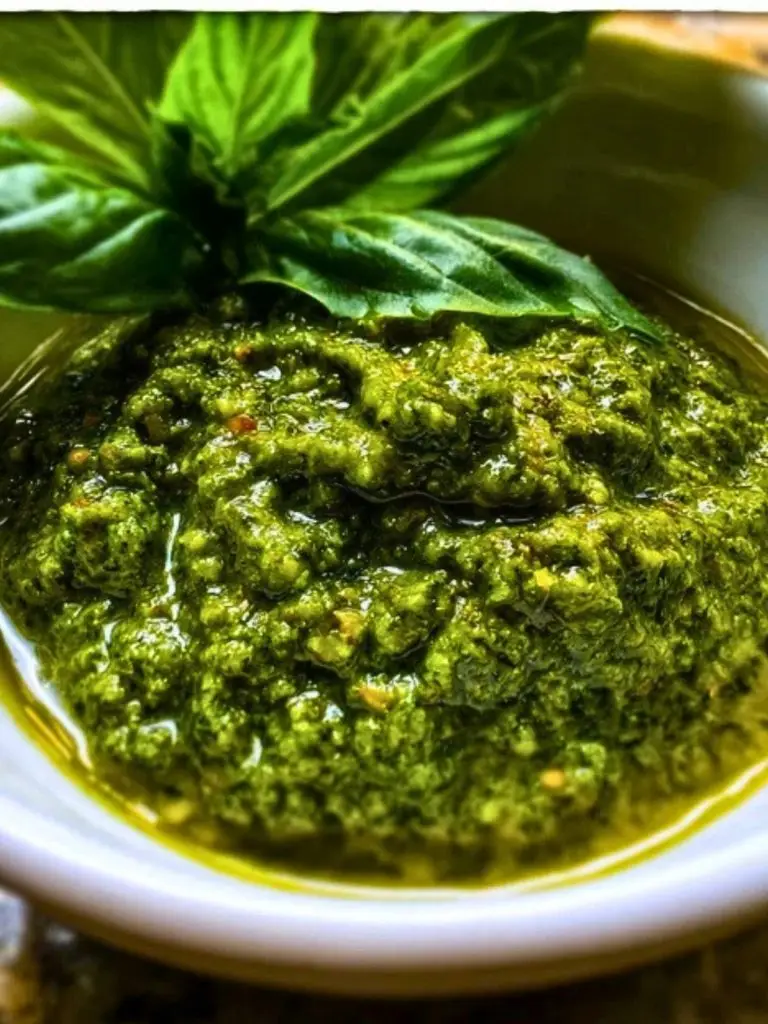
Ingredients for the Classic Basil Pesto
Fresh Basil Leaves
This is the heart and soul of your pesto. Look for vibrant green leaves with no dark spots or wilting for the best flavor and appearance.
Pine Nuts
They lend the creamy, nutty base that pesto is known for. Lightly toasting them before blending brings out their flavor even more.
Garlic Cloves
A must for that signature pungent depth. Adjust to taste depending on how bold you want your pesto.
Parmesan Cheese
Aged Parmesan adds sharpness and saltiness. Make sure it’s freshly grated for a smoother blend and fuller taste.
Extra Virgin Olive Oil
Quality is crucial here. Use the best you can afford, as it ties everything together with its silky texture and peppery finish.
Salt
Just a pinch brings balance to the pesto, enhancing each element without overpowering the whole.
How To Make the Classic Basil Pesto
Step 1: Prep Your Ingredients
Rinse and pat dry your fresh basil leaves. Toast the pine nuts in a dry skillet over medium heat for 2–3 minutes, stirring constantly until golden and fragrant. Peel the garlic cloves and grate the Parmesan cheese if it isn’t pre-grated.
Step 2: Start the Blend
In a food processor or high-powered blender, combine the basil leaves, toasted pine nuts, and garlic cloves. Pulse several times until coarsely chopped. You want everything broken down but not fully smooth just yet.
Step 3: Add the Cheese
Add the freshly grated Parmesan to the basil mixture. Pulse again to incorporate it evenly throughout the base.
Step 4: Stream in the Olive Oil
While the processor is running, slowly drizzle in the olive oil. This creates that classic creamy, emulsified texture. Scrape down the sides as needed and blend until you reach your desired consistency.
Step 5: Season to Taste
Add a pinch of salt and pulse one last time. Taste and adjust as needed—a bit more salt, a clove more garlic, or even a splash more olive oil depending on your preference.
Step 6: Use or Store
Use your pesto right away for peak flavor, or transfer it to a jar with a tight lid. Pour a thin layer of olive oil on top to keep it fresh and store in the fridge for up to a week.
How to Serve and Store This Classic Basil Pesto
Pesto is one of the most versatile sauces you can keep in your kitchen. Toss it with freshly cooked pasta, spoon it over roasted vegetables, swirl it into soups, or use it as a punchy sandwich spread. It also makes a gorgeous topping for grilled chicken, salmon, or even scrambled eggs.
To store it, scoop the pesto into an airtight jar or container, and top it with a thin layer of olive oil to prevent oxidation. Keep it in the fridge for up to 1 week. For longer storage, freeze it in ice cube trays—then transfer to a zip-top bag so you can grab a portion whenever you need a burst of flavor.
Frequently Asked Questions
Can I freeze pesto?
Yes! Pesto freezes beautifully. Pour it into ice cube trays, freeze until solid, then transfer the cubes to a freezer-safe bag. This way, you can defrost just what you need.
What can I use instead of pine nuts?
Walnuts, almonds, or sunflower seeds are great alternatives. Each will slightly change the flavor, but still give you that rich, nutty texture.
Is it okay to use pre-grated Parmesan?
It’s best to use freshly grated Parmesan for the smoothest consistency and strongest flavor. Pre-grated can be clumpy or overly salty.
How do I fix bitter pesto?
Bitter pesto is usually from over-blending the basil or using a poor-quality olive oil. Try adding a splash of lemon juice or a bit more cheese to mellow it out.
Can I make it vegan?
Absolutely. Just swap the Parmesan for a vegan hard cheese or a tablespoon of nutritional yeast to keep that savory, cheesy profile.
Why is my pesto turning brown?
Oxidation! To prevent this, always store it with a layer of olive oil on top and use airtight containers. Using lemon juice in the blend can also help preserve the vibrant green color.
Want More Sauce & Spread Ideas?
If you love the bold, herbaceous flavor of this classic basil pesto, you’ll definitely want to check out these other vibrant and flavor-packed options from the Life with Jam kitchen:
- Try this zippy Louisiana Remoulade Sauce for a creamy Cajun twist.
- Warm up with a comforting bowl of Easy Thai Red Curry Dumpling Soup that features a broth begging for a pesto drizzle.
- For something punchy and herby, don’t miss this Spicy Sailor’s Dip with a flavor kick.
- Or balance your savory pesto with something sweet like this Grilled Peach and Honey Mustard Dressing.
- Looking for pasta pairings? Try this Creamy Garlic Parmesan Tortellini with Sausage and Broccoli for a perfect match.
Save This Pin + Share Your Results
📌 Save this recipe to your Pinterest board dedicated to sauces or condiments so you never lose it.
And if you give it a try, let me know how it turned out! Did you swap the pine nuts for walnuts? Go heavy on the garlic? I’d love to hear how you made it your own.
For even more daily kitchen inspiration and easy-to-follow recipes, follow me on Pinterest at Life with Jam. You’ll find ideas to brighten up every dish, every day.
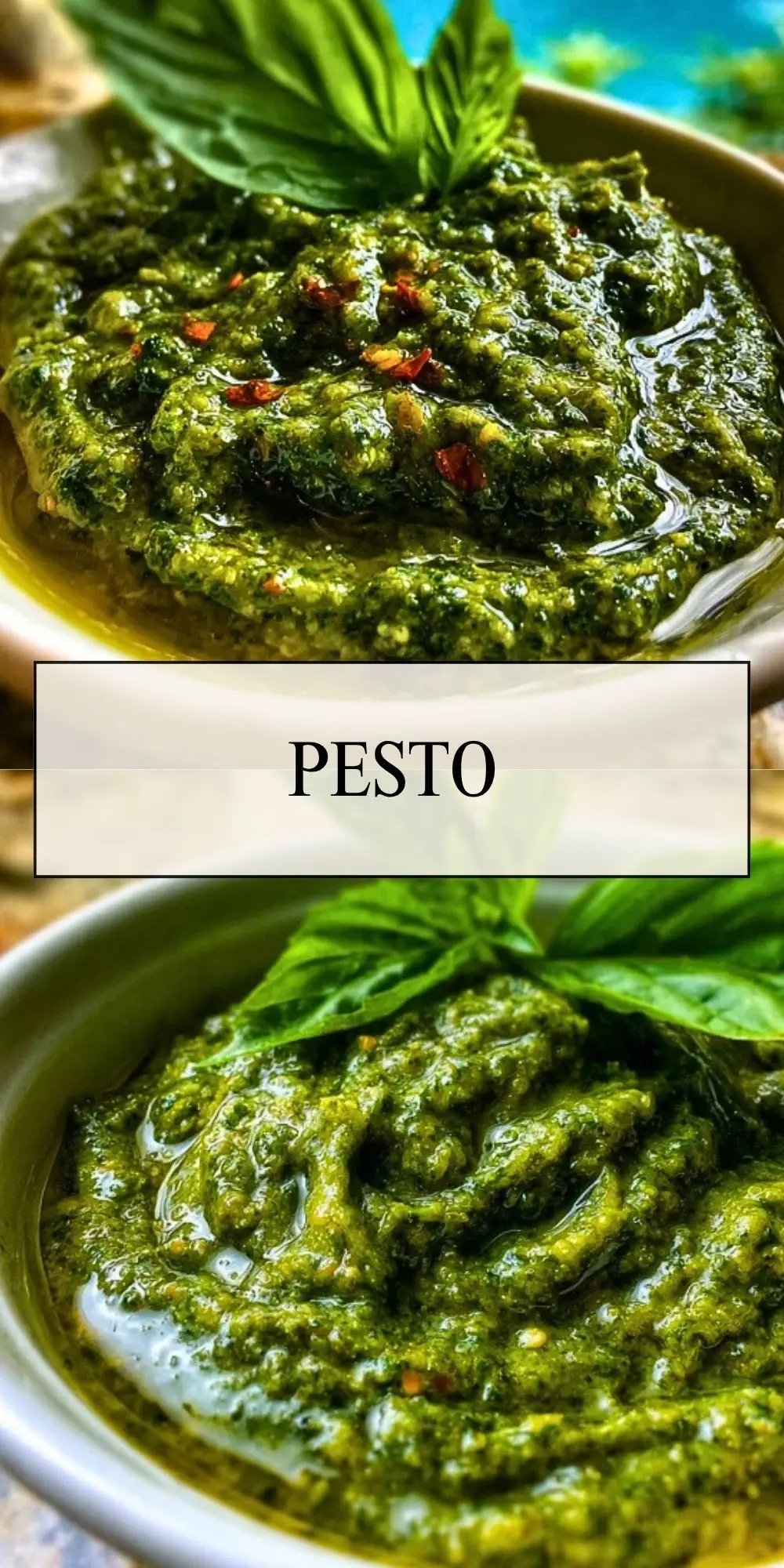

Classic Basil Pesto
- Total Time: 13 minutes
- Yield: About 1 cup
- Diet: Vegetarian
Description
Classic basil pesto is a fresh, vibrant Italian sauce made with fragrant basil, toasted pine nuts, sharp Parmesan cheese, and rich olive oil. This simple yet flavorful condiment adds bold, herby depth to pastas, sandwiches, soups, and more.
Ingredients
2 cups fresh basil leaves
1/2 cup pine nuts (lightly toasted)
2 cloves garlic
1/2 cup freshly grated Parmesan cheese
1/2 cup extra virgin olive oil
1/4 teaspoon salt
Instructions
1. Rinse and pat dry the fresh basil leaves. Toast pine nuts in a dry skillet over medium heat for 2–3 minutes, stirring constantly. Peel garlic and grate Parmesan.
2. In a food processor, combine basil, toasted pine nuts, and garlic. Pulse until coarsely chopped.
3. Add grated Parmesan to the mixture and pulse again to combine.
4. With the processor running, slowly stream in olive oil until creamy and fully blended. Scrape down sides as needed.
5. Add salt, then pulse to finish. Adjust seasoning to taste.
6. Use immediately or store in a jar with a layer of olive oil on top. Refrigerate for up to 1 week.
Notes
Always use fresh basil leaves for best color and flavor. Avoid wilted or darkened leaves.
Lightly toasting pine nuts enhances their nutty flavor. Watch closely—they burn fast!
Add a squeeze of lemon juice if your pesto turns out bitter or if you want extra brightness.
- Prep Time: 10 minutes
- Cook Time: 3 minutes
- Category: Sauces & Condiments
- Method: Blended
- Cuisine: Italian
Nutrition
- Serving Size: 2 tablespoons
- Calories: 210
- Sugar: 0.2g
- Sodium: 150mg
- Fat: 21g
- Saturated Fat: 3.5g
- Unsaturated Fat: 17g
- Trans Fat: 0g
- Carbohydrates: 1g
- Fiber: 0.3g
- Protein: 3g
- Cholesterol: 5mg
